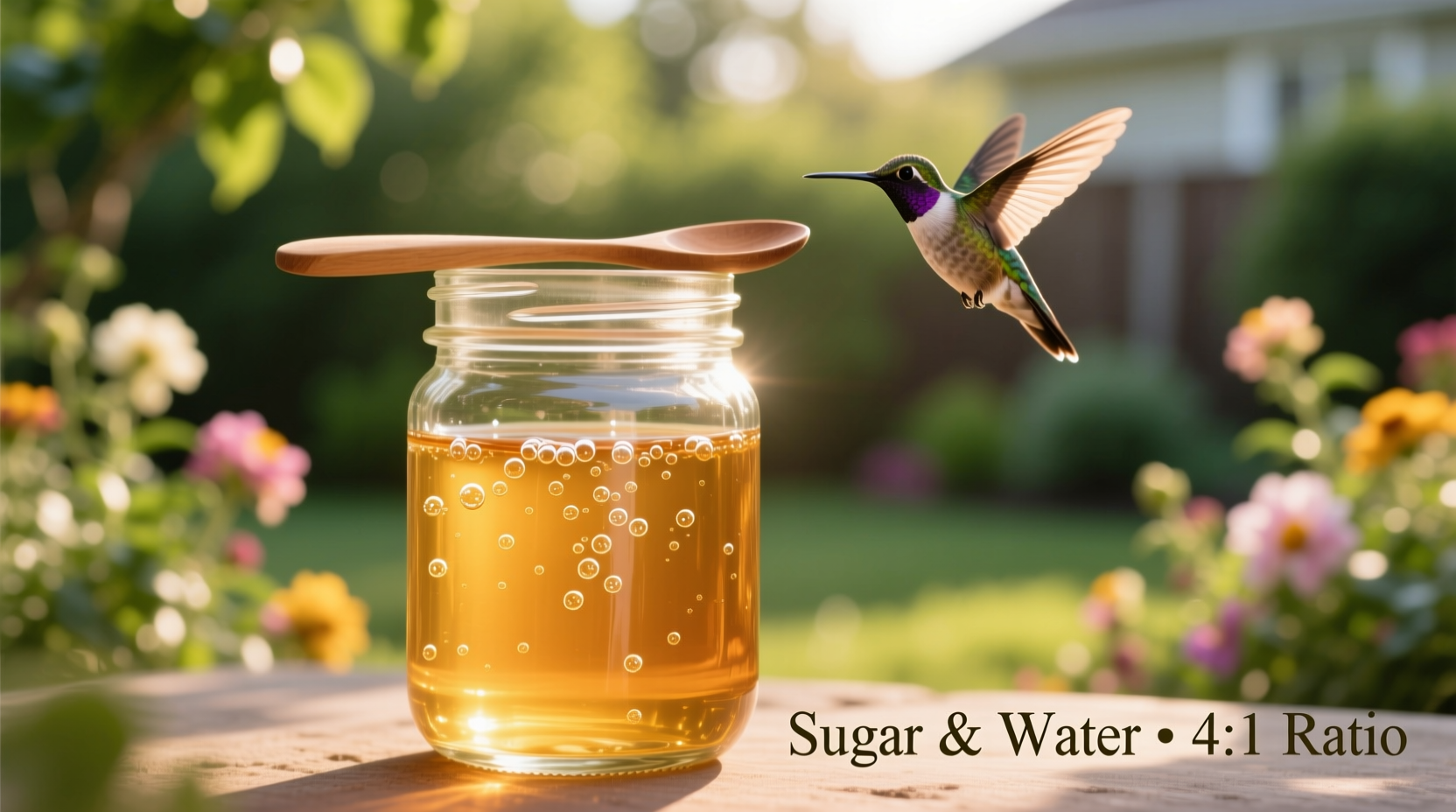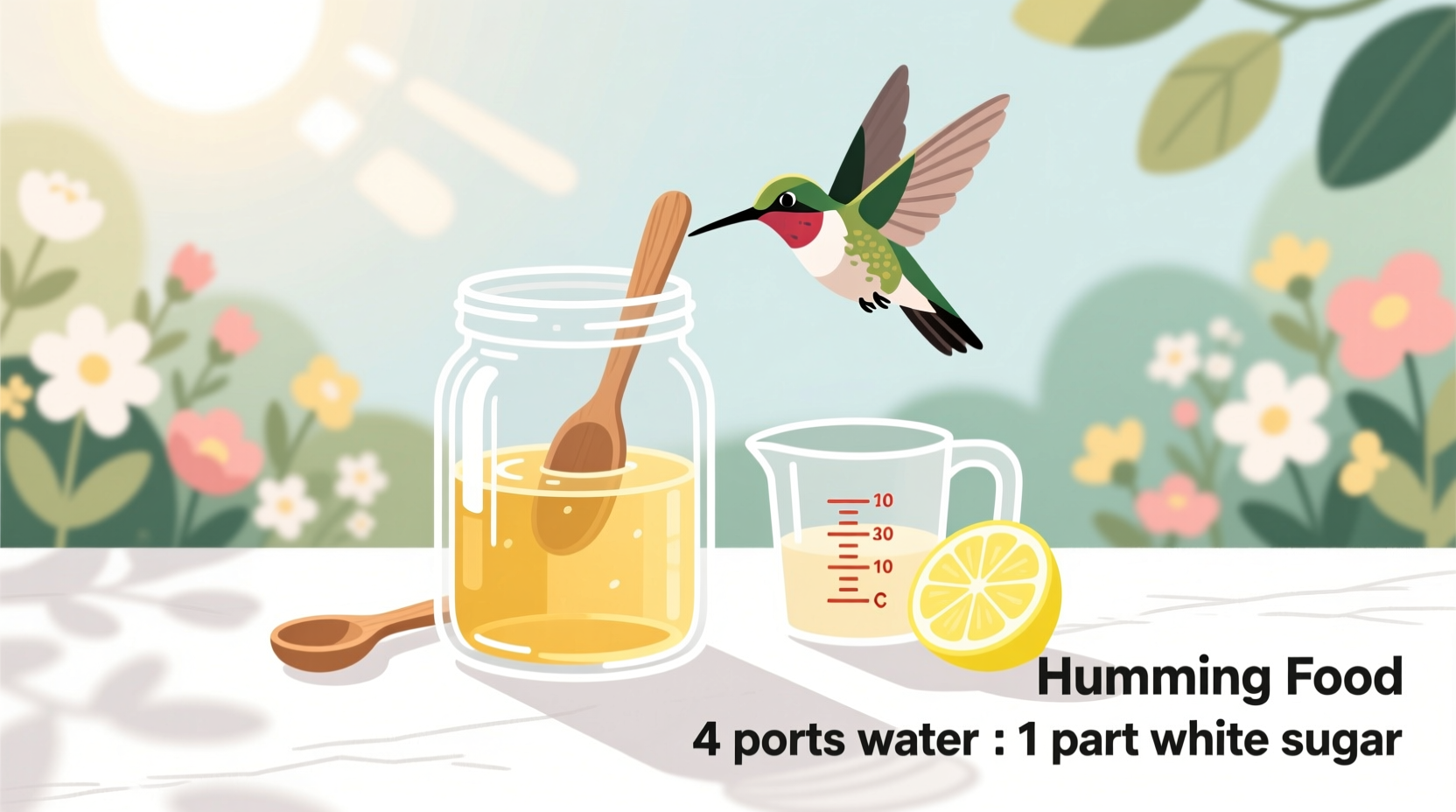Creating safe, nutritious hummingbird food is easier than you think, and your backyard visitors will thank you. This guide provides science-backed instructions that keep hummingbirds healthy while saving you money compared to commercial nectars. Forget complicated recipes - the birds prefer simplicity.
Why Homemade Nectar Beats Store-Bought
Commercial hummingbird food often contains preservatives and red dyes that serve no purpose other than attracting human buyers. Hummingbirds find feeders through color (the feeder itself should be red), not dyed nectar. By making your own, you control exactly what goes into the solution, ensuring it matches the natural sugar concentration of their preferred flowers.
| Safe Ingredients | Unsafe Ingredients | Why It Matters |
|---|---|---|
| White granulated sugar | Honey | Honey ferments quickly and can cause fatal fungal infections |
| Tap water (boiled) | Artificial sweeteners | No nutritional value and may contain harmful chemicals |
| Spring water | Red food coloring | Linked to kidney issues in hummingbirds; unnecessary |
| Brown/powdered sugar | Contains iron and other minerals harmful to hummingbirds |
Gathering Your Supplies
You'll need minimal equipment for hummingbird food preparation:
- Medium saucepan
- Measuring cups
- Clean spoon for stirring
- Airtight container for storage
- Hummingbird feeder (red elements on the feeder itself, not in nectar)
Step-by-Step Nectar Preparation
- Measure 1 cup of white granulated sugar
- Measure 4 cups of water (tap water is fine)
- Combine in saucepan and bring to a gentle boil
- Stir until sugar completely dissolves (about 2 minutes)
- Remove from heat and let cool completely to room temperature
- Pour into clean feeder

Maintenance Schedule Based on Temperature
How often you change the nectar depends on your local climate. This timeline ensures your solution stays fresh and safe:
- Below 70°F (21°C): Change every 5-7 days
- 70-80°F (21-27°C): Change every 3-5 days
- Above 80°F (27°C): Change every 2-3 days
- After rainy periods: Change immediately (water dilutes sugar concentration)
The Cornell Lab of Ornithology confirms that maintaining proper sugar concentration is critical for hummingbird health. Their research shows that solutions stronger than 1:3 ratio can damage hummingbird kidneys, while weaker solutions don't provide enough energy.
Cleaning Your Feeder Properly
Before refilling, thorough cleaning prevents mold and bacteria growth:
- Disassemble all parts of the feeder
- Soak in solution of 1/4 cup white vinegar to 1 cup water for 1 hour
- Scrub with bottle brush (no soap needed)
- Rinse thoroughly with hot water
- Allow to air dry completely before refilling
Troubleshooting Common Issues
Nectar turns cloudy quickly: This indicates bacterial growth. You're likely not boiling the mixture long enough or not cleaning your feeder properly between fillings.
Ants in your feeder: Use an ant moat (available at garden stores) filled with water - it creates a barrier ants can't cross.
Bees or wasps swarming feeder: Move the feeder to a shadier location. Bees prefer sunny spots. Avoid yellow elements on your feeder, as they attract bees.
Remember that during cold snaps below freezing, hummingbirds naturally seek alternative food sources. Don't waste nectar by filling feeders when temperatures remain below 40°F (4°C) consistently, as the solution will freeze and become inaccessible.
When Homemade Nectar Isn't Enough
While our hummingbird food recipe works year-round in most conditions, there are specific situations where natural food sources are preferable:
- During spring migration when hummingbirds need protein from insects
- In extremely hot weather above 95°F (35°C) when sugar concentration can become too high through evaporation
- When you notice sick or injured hummingbirds at your feeder (contact a wildlife rehabilitator)
Planting native flowering plants that hummingbirds prefer provides more complete nutrition than nectar alone. The National Wildlife Federation recommends combining feeders with trumpet vine, bee balm, and cardinal flower for optimal hummingbird support.
Can I use organic sugar for hummingbird food?
No, organic sugar often contains molasses residues that can be harmful to hummingbirds. Stick with regular white granulated sugar which most closely matches the sucrose composition of natural flower nectar.
How long can I store unused hummingbird food?
Refrigerate unused nectar in a clean, airtight container for up to 7-10 days. Discard if cloudy or develops an odor. Never freeze hummingbird food as this alters the sugar concentration when thawed.
Why shouldn't I add red food coloring to hummingbird nectar?
Red dye has been linked to kidney problems in hummingbirds. The feeder itself should have red elements to attract birds - the nectar should remain clear. Hummingbirds find feeders through color, not colored liquid.
What's the best time of day to fill hummingbird feeders?
Early morning is ideal, as hummingbirds feed most actively at dawn and dusk. Fill feeders when temperatures are cooler to minimize immediate evaporation and bacterial growth.
How can I keep bees away from my hummingbird feeder?
Move feeders to shadier locations (bees prefer sun), avoid yellow elements on feeders, and consider saucer-style feeders with built-in bee guards. Never use insecticides near feeders as these can harm hummingbirds.











 浙公网安备
33010002000092号
浙公网安备
33010002000092号 浙B2-20120091-4
浙B2-20120091-4